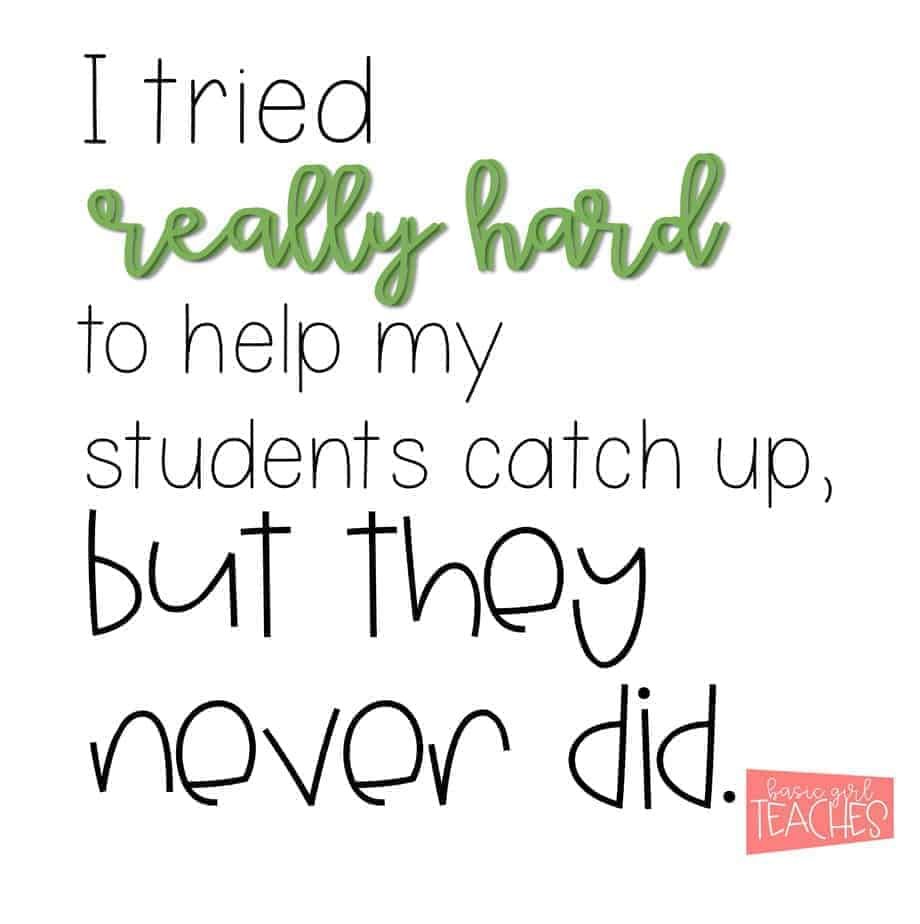Easy Reteaching Strategies for the 21st Century Classroom Using Data
Odds are, no matter what topic you’re discussing or what grade levels you teach, you will not have 100% of your students master the skill the first time you teach it. This isn’t because we’re all terrible teachers; it’s because students learn in different ways and at different paces. This means that you will always have to schedule the time to reteach and take this into consideration when crafting a formative assessment.
In order to determine what you need to reteach, you’ve probably collected a lot of data: assessment scores, exit tickets, universal screeners, benchmark scores, etc. Looking at all of this data can be suuuuper overwhelming. How do you know what “level” a student is on, anyway? If you’re like me, you probably started grouping kids by high, medium, and low using rather arbitrary rules like “they scored below 50% on the unit test,” or “they’re just low on every topic.”
Here’s a great way to organize your reteaching strategies with a new method and take your reteach groups to the next level.
First off, what exactly are reteaching strategies? Reteaching strategies are what you do to address the needs of students who did not achieve mastery in a skill after initially teaching it. There are three main types of reteaching strategies in groups that are traditionally used:
Note that these groups may contain subsets, which can help you differentiate for various students! For instance, you might have students who fall into multiple categories, or students who are in the same category but need different strategies.
Scenario #1: Students “Flunk” the Test
For many of us, this scenario can be pretty common!
One possibility is to have a reteach group for each student who scored below the benchmark score, and then another group for everyone else. You can easily organize your reteaching strategies into stations or centers so students can work independently, depending on student needs. If you have 3 students with low scores, you can have them work together on the same strategy at the same time.
But what if you have 10 students who scored below the benchmark? You could just pair them up with another student, but this may lead to slower progress for both students.
A better problem-solving option would be to divide these 10 students into two groups of five, labeled “reread” and “practice problems.” Why? Well, it might be that some concepts are just harder for these students to grasp than others.
So if you have the five students who scored low on different sections work together at one station, you can help them all work through their difficulties with each skill and build on that prior knowledge. If you have the five students who scored low on the same skill work together at another station, you can give them some practice problems to work through.
This will allow students to focus on their individual needs while keeping pace with their peers and grade-level content.
Scenario #2: Students Missed Benchmarks or Scored Below Expectations
If your school does not use scores to assign students into groups, then you may have data that looks different, which just means you need to look at different methods for success. For example, your school may use benchmark scores instead of state assessments. Maybe some students missed benchmarks by a small margin (below 70%) and others scored below expectations (below 60%).
If this is the case in your school, you could organize reteach groups based on benchmark scores. For instance, students who scored below the department average would be placed in one group and those who missed benchmarks by a small margin would be in another.
Scenario #3: Students Missed Benchmarks or Scored Below Expectations, PLUS Students “Flunked” the SST
Even if your school only uses test scores to assign students into groups to implement your reteaching strategies, some students may have “flunked” the SST. This means that they scored below 50% on the unit test after teaching it.
Now it can be really easy to just sort these students into a group and teach them all the same strategies. But if you have heterogeneous class periods, this may cause some students to fall behind while others might get bored really fast!
A better option would be to create two reteach groups for each student who scored below the benchmark. One group would contain students who missed benchmarks by a small margin, and another group would contain those whose scores were well below expectations, focusing still on those individual levels.
You can label these two groups “reteach” and “independent practice.” The reteach group will go over the same skills and main ideas as a whole class, while the independent practice group gets a separate set of strategies to work through. This is going to work better for your students because you can address both the needs of students who missed benchmarks by a small margin and those whose scores were well below expectations.

The Old Strategy
I’ve been using the guided math model of instruction in my classroom for years. I teach 4 small groups every day: 3 regular groups and 1 reteach group. I used to create my reteach groups after we took the unit test. I would look at the scores on the test and divide my students into four groups like this:
– 0-49% on the test (Below Level)
– 50-74% on the test (Approaching Level)
– 75-84% on the test (On-Level)
– 85-100% on the test (Above Level)
Then I would start the new unit, and I would pull the students who were below level during my reteach time to reteach the content from the previous unit. As they started to understand the concept, I would stop pulling them.
Here’s the problem with this method: I could have created those groups long before we took the test. I knew which students didn’t get it. But I didn’t have time to implement my reteaching strategies because I was using my reteach time to teach content from the previous test. It was like this never-ending cycle where I tried really hard to help students catch up, but they never did. This is not using true data for reteaching strategies.
A Better Way by Using Real Data
I knew I needed to do something different, so I studied all the information I could find on intervention and reteaching and I came up with a much better system using very specific data for reteaching strategies. As soon as I stopped waiting for the test to start reteaching, I noticed huge gains in my students’ understanding of new content. Here’s how this process works in my classroom:
1. I give an exit ticket at the end of EVERY small group lesson. I watch the students as they work and give immediate feedback. I reteach content as needed right then while they are still at my table.
2. I use these data tracking guides to keep track of each student’s exit ticket work. I take notes about WHY they need to be retaught. (Example: My lesson was about representing multiplication by making groups and by drawing an array and the exit ticket gave the students a problem and asked them to solve with both groups and an array. The student uses the array correctly but makes groups incorrectly. In the notes section, I would write the student’s name and that they needed to reteach with groups.)

3. When I’ve finished teaching my three regular groups, I quickly go through the data on my tracking guide and divide the students into groups based on their misconceptions and errors. (Example: Using the same lesson from before, let’s say I had three students who needed reteach with groups, four who needed to use reteaching strategies with arrays, and two who needed to reteach with both strategies. I would highlight or otherwise mark those three groups on the guide.)
4. I call the students for reteaching strategies on the same day. Depending on how many reteach groups I’ve made, I call the students different ways. (Example: Using the same lesson from before, I would call the 2 who needed both strategies and the 4 who needed to reteach with arrays at the same time. I would reteach arrays.
As the 4 started to understand, I would give them the exit ticket to try again and record the data on my tracking guide, then send them back to their stations. I would keep the 2 who needed both strategies at my table and call the other 3 who needed to reteach with groups. I would repeat the same process: teach, exit ticket, record, return).
This strategy is based on research on assessment design conducted by Nicole Vagle.
So What?
Of course, I still have students who don’t get it after the test, but that number is much smaller than it used to be. I am now able to focus on reteaching strategies past content during our schoolwide intervention time. I use a similar process to sort students into groups after the test. As I grade the test, I identify the general errors or misconceptions struggling students are making and sort the students into groups based on specific concepts they need to be taught, not based on the score they made on the test.

This strategy transformed my classroom. I was no longer waiting for my students to fail before I helped them – I was making space to correct their errors as I saw them. Austin Buffum said, “A good conductor won’t wait for the concert to see if their musicians can perform. Likewise, a good educator shouldn’t wait for the test to see if their students know the content.”
Using the tracking guides to organize my data and direct my analysis of the data enables me to target my instruction to exactly what my students needed.
Unorganized data is essentially just strings of numbers. This system allows me to get to the root of WHY students need help. Instead of just treating the symptom of the problem or the test score, I’m able to fix the cause of the problem.
Stop Driving the Teacher Struggle Bus
Are you struggling with student engagement, apathy, or keeping your class on track?
💫💫 There’s hope! 💫💫
Join my free teacher workshop “Choosing Choice” and in just 60 minutes, you’ll craft a practical plan to revitalize your teaching. Discover the magic of student choice in boosting engagement, gain quick implementation ideas, and explore strategies for year-long success.
Unlike overwhelming workshops, my approach guides you in real-time, providing more classroom options, reducing stress, and giving you more personal time.
Plus, you’ll earn a 1-hour professional development certificate and have 7 days of access.
Don’t miss this chance to transform your teaching; click below to secure your spot now!
This post was contributed to by Jamie Jasperson, founder of Basic Girl Teaches. She teaches 4th Grade Math and Science in Texas and is known for her easy-to-use, no-fluff resources. She is the founder of The Teacher Instagram Club, a free community to help teacherprenuers use Instagram to grow their business or brands. You can connect with Jamie on Instagram or email her at basicgirlteaches@gmail.com






